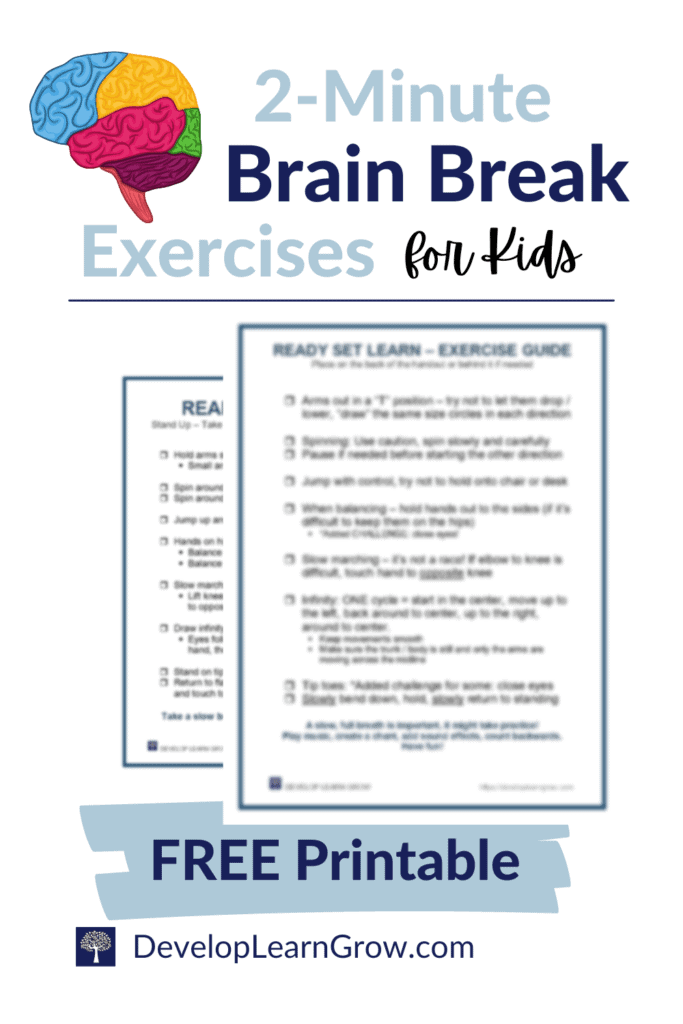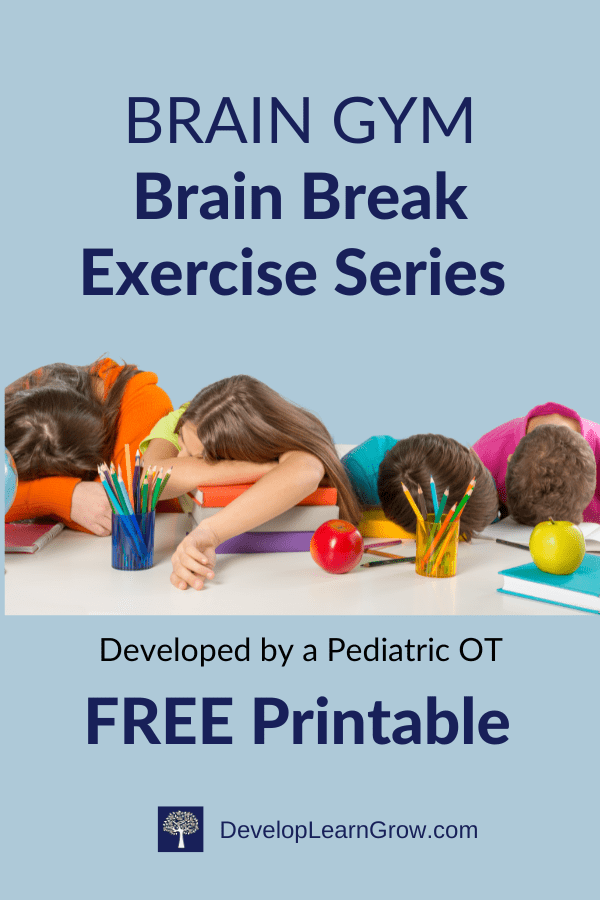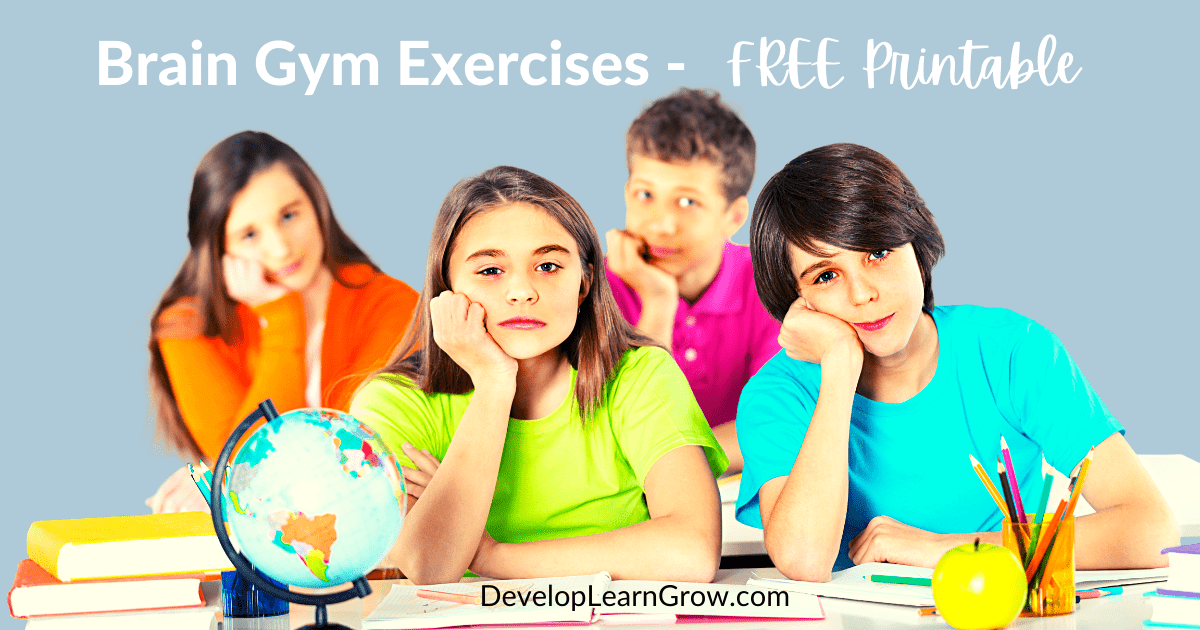This FREE handout of brain break exercises provides a great combination of physical activity to get your students ready for learning during the school day. Moving a variety of body parts means stimulating more parts of the brain – creating stronger pathways and connections for cognitive function!
There are several brain break activities, gross motor exercises and physical movement programs online. When you’re searching, you may find more options that you need to.
Google is making great attempts to ensure that high quality content is available from real people. Real people with experience, expertise, authoritativeness, and trustworthiness. You deserve to know what’s effective and what has value from a reliable source.
Over the decades of working as a pediatric occupational therapist, I’ve been so drawn to sensory integration. I’m fascinated by the nervous system and its impact on learning, attending and behaving!
Simple sensory activities can have such powerful effects on younger kids’ nervous systems.
As a therapist working in the schools, I strongly encourage teachers to incorporate physical activity as part of the daily routine for kids. Specific movements and exercises are a great way to increase energy levels and attention span.
A child’s brain needs prepared for learning. Specific movements help different parts of the brain communicate better. The movements wake up the brain and increase blood flow. They help strengthen learning pathways and cognitive function.
The Pyramid of Learning shows how the sensory systems are the foundation for academics. A sensory break is a fun way to boost brain development.
What Are Brain Breaks?
Brain breaks are short breaks that are taken at regular intervals throughout the school day.
Expecting a student to sit still and pay attention all day to lessons will not yield good results!
It’s not how younger kids (and older kids) operate. They cannot attend for that long. Their brains need a variety of input and learning modalities. And they need frequent breaks from learning.
And let’s be honest, the new learning standards tend to be too much for many younger kids. With higher expectations for kids, a much-needed mental break should be built into the school day more now than ever before.
Fun brain breaks can include jokes, telling stories, a fun song or rhyme, and playing a fun game. A classic game I remember from elementary school is Heads Down Thumbs Up 7-Up. Fun games improve memory and learning.
When kids have fun, it impacts the part of the brain that supports memory. Simple fun brain breaks also temporarily shift focus and re-set the brain.
Movement breaks for kids can include quick movement exercises, follow the leader, core strength activities, Simon Says, or dancing. (The Learning Station is full of dancing songs.)
Brain breaks can also include mindfulness exercises such as deep breathing, calming background music, or arts and crafts.
All of these different types of brain breaks help create a positive classroom environment.
With an overall decrease in physical activity in kids, movement brain breaks like the exercise series in this blog post are more important than ever.

When to Use Brain Break Exercises
I’ll never forget meeting with two learning support teachers. The school where they taught had an EXCELLENT special education program.
The teachers wanted to talk to me about using more sensory strategies and physical movement with their students.
They were young and eager teachers, excited to get together to ask questions. We didn’t have much time to meet but it didn’t take long to share simple brain break ideas.
I briefly explained activities including the easy exercises listed in the printable on this post. They recognized how beneficial the info and strategies would be for ALL of their students before lessons and tests!
The teachers not only wanted to use them with their learning support students, but they wanted the entire regular education classes that they worked in to do them.
They recognized that ALL elementary students need something extra in order to help them focus. I’m sure you see it too!
The brain break exercises on this handout are simple and easy for kids. They can be done before a test or before any important learning activity. The entire series will take less than two minutes so it’s super easy to plug into your daily schedule.
You can teach the sequence and lead your students the first couple of times. Then, the leader of the day or week can take charge of the exercise sequence (as you’re grabbing items needed for the test or your lesson!)
Older students can take turns leading this sequence throughout the year.
This is a great list of quick exercises to use before a test or learning activity. However, this sequence can be used ANY time your kids need a break. More brain break ideas are listed at the end of this post if you would like more ideas for your teacher toolbox!
Brain Break Activities for the School Day
Brain breaks are a fun way to give younger and older kids the input that their nervous system needs.
Have you heard of the term “Use it or lose it”? My 94 year old grandmother has said this for decades.
It’s so true! We all need to keep moving. The more you use your body, the more you strengthen the brain.
Your brain is an extremely adaptive organ. There’s constant neural activity occurring every millisecond. Your brain is constantly taking in information both inside and outside of your body and it has to process, organize and respond to the information – at an incredibly rapid pace!
Children’s nervous systems are less mature. They need more input through different systems of the body in order for the brain to focus. Especially physical movement.
Sadly, their bodies are different than they used to be. Baby, toddler and child play is very different now! I’m seeing much less outdoor play time, not as much creativity, decreased opportunities to use the hands for play… and the worst part: increased screen use!
This makes it very challenging for you in the classroom!
More reason for you to use educational brain breaks to keep these kids moving so they don’t lose it.
PDF Brain Break Exercise Sequence Tips
The following quick Brain Break Exercise Sequence only takes about two minutes.
It includes physical movement activities to improve posture, core strength, balance, cross-lateral movements, and crossing midline. Heavy work activities and vestibular exercises are also included to increase alertness in kids.
Some of the exercises are part of the Brain Gym Series. Research has shown the increase in academic achievement when these exercise movements are part of the daily routine when learning.
I’ve practiced this sequence and have handed it out to several teachers. Kids love it. I always remind them, “moving our bodies helps strengthen our brains!”
For these exercises, students will need to stand up at their desks or tables. I tend to make sure kids have enough room around them to be safe. I
t’s a good idea to make sure chairs are pushed in, the floor is clear, and kids do not stand too close to furniture. When counting, lead the students in a rhythmical manner. Make sure the counting and movements are consistent for both sides of the body.
I created two pages… you only need the first page of this brain break resource. The second page is just an FYI guide with explanations if needed. (It could be placed in a page protector with the exercise guide on the back.)
Below are the exercises on the printable with my OT perspective and explanation of each.
Arm Circles
Arm circles help with posture, shoulder stability, blood flow and body awareness. So many students struggle with having stable shoulder muscles. This is such an easy one to plug into the day.
Make sure kids keep their arms straight to the sides. After the circles, have them freeze and keep their arms out. Then, teach them to slowly lower their arms with good control when finished.
Slow Spins
Spinning around is a great way to alert the vestibular (movement system) for learning. Please make sure students are being safe. Start with slow spinning until they gain better control.
Jumping
Jumping gives proprioceptive and linear vestibular input for the brain which is very organizing and alerting.
Make sure there’s room around their desk and that their chair is pushed in. Don’t allow them to hold onto anything when jumping.
Balance on One Leg
When balancing on one leg, make sure kids try to hang on to their chair or desk for support. Ideally, hands should be held on hips but they can be held out to the sides to help with balance if needed until they improve.
For students who have good balance, have them close their eyes to add more of a challenge. Start with the right foot, then move to the left foot.
Cross Crawls
During the cross crawls (slow marching,) have kids focus on making sure the opposite elbow is touching the opposite knee.
Some students’ brains will have a hard time using cross lateral movements. You may see the right elbow touch the right knee, especially in younger students. Check to make sure they are reaching over to the opposite side and model directly in front of them so they can mirror your movements.
Cross crawl movements are so important for kids. Following this simple cross-lateral marching motion activates the top, bottom, right, left, front and back parts of the brain!
One simple motion, if done correctly, increase so much neural activity!
Infinity Loop / Lazy 8
The infinity motion is very important for crossing midline and it helps the eyes visually track the fingertips and also cross midline.
If your students can’t visualize this motion, draw a large visual in the front of the room or place it on your projector. I carry around a laser pointer on my id badge and project the dot on the front of the class for them to follow. Kids love this!

When following the infinity loop, have kids point with their index finger and follow this motion:
INFINITY MOTION: Start at the center – move up to the left – back around to the center – up to the right – back around to the center (that’s ONE cycle). Use this same continuous motion for the right hand, left hand and then both hands together.
When pointing with each finger separately and when moving both hands together, make sure students are keeping their head and body still and only moving their arms around the infinity loop (this really encourages better crossing midline.)
Balance on Toes
One thing that I’m finding with elementary students is that standing is now somehow sooo physically taxing for them! They are so used to plopping in chairs. When completing fine motor activities in a standing position, many kids often lean against furniture.
So when balancing, please don’t let them hold onto anything.
The balance system helps with core strength and it helps support the visual system. Vestibular activities help direct the rest of the nervous system.
Cue kids to carefully stand on their toes. For your more active kids with good balance, have them close their eyes for more of a challenge.
Toe Touches
When having the students touch toes, a pause at the bottom increases blood flow to the brain, gives great input to the vestibular system, and helps increase alertness.
Make sure they stand completely up in between each toe touch if you add a couple of extras.
Deep Breathing
Finally, a deep breath helps to get oxygen to the brain. You’d be surprised how many of your students have shallow breathing throughout the day. I see WAY to many kids hold their breath when they focus on a task which is not good for the brain!
Breathing slowly through the nose is my preference (for many reasons) but not always possible for all students. The breathing is also helpful to ease nervousness before tests!
You’re welcome to repeat the deep breath more than once if you’d like! It may take a lot of practice for your students to be able to breathe slowly, hold and exhale slowly.
(Tip: In addition to the brain break exercises, have your students sip water throughout the day to hydrate their brains!) Wake the Brain with Proven Oral Sensory Activities shares more powerful tools for the mouth and special strategies that increase focus and alertness.
Enjoy these exercises and keep reading for more brain break ideas.
Click below for access to the free printable. It will be emailed to you.
Additional Supports to Improve Student Performance When Learning
Brain break exercises are a great way to re-set and re-focus students’ brains for learning. Research shows that movement breaks increase learning and engagement.
You can use additional supports in your learning environment. Offer flexible seating options. These are great for posture, core stability and attention (if the right flexible seating choices are made.)
Adding Core Exercises for Kids will help increase alertness. SOOO many kids lack core strength right now. It’s becoming a bigger problem in the schools that I work in. This core exercises post has another free printable available for you.
In addition to classroom exercises, you may have a few students that might get overstimulated and need quiet breaks. Calming Deep Pressure Weighted Tools are a good idea to use. The relaxing sensory tools provide proprioceptive deep pressure input that calms the nervous system.
More for YOU! Brain Break Exercises in the Classroom, 8-Week Challenge for Kids
This classroom exercise program offers 8 weeks of exercises. Each week has a list of several, quick brain breaks that focus on sensory, sensory motor and fine motor development.
The goal of the program is to practice the same sequence of exercises every day for one week. This gives kids a chance to work on improving the skills, rather than throwing random brain break exercises at them every day.
Use these specific occupational therapy exercises to improve:
Attention… focus… core stability… crossing midline… sensory processing… visual development… & more… Click for more info!
More Fun Brain Break Ideas for Kids:
25 Brain Breaks for Kids – Improve Focus and Attention – Use proprioceptive input to calm and alert the nervous system to increase focus in kids. A free printable is available.
Movement Activities to Enhance Learning – Use alerting movement activities to increase focus in kids. These are very easy to plug into your daily routine.
48 Alerting Exercises to Increase Focus and Attention – Use activities for 6 of the sensory systems to increase alertness in kids.





0 Comments